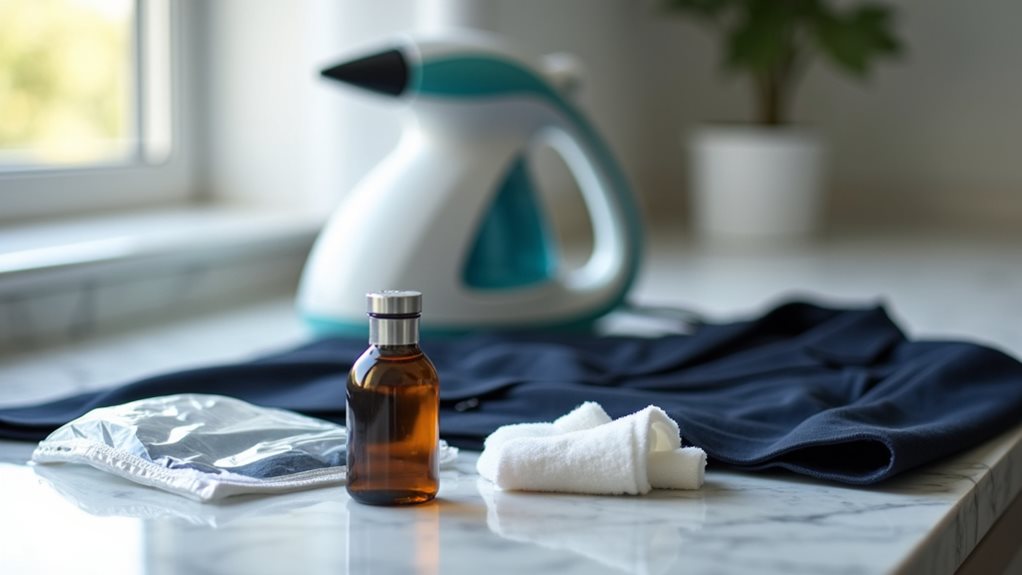Home dry cleaning kits work by using your dryer’s heat to activate special cleaning cloths that release steam and cleaning agents, which then penetrate fabric fibers to break down stains and eliminate odors. You’ll place your garments in the included Mylar bag with these heat-activated sheets, and as the dryer warms up, emulsifiers help lift oil-based stains while steam loosens dirt particles—though they’re best for light stains and delicate fabrics like silk, and there’s much more to understanding their effectiveness.
What Are Home Dry Cleaning Kits
Innovation has a funny way of sneaking into our laundry rooms when we least expect it, and home dry cleaning kits represent one of those clever solutions that makes you wonder why nobody thought of it sooner.
These clever little packages contain everything you need to refresh your delicate fabrics without leaving your house, including a trusty stain remover, a special Mylar bag, and steam-generating sheets that transform your regular dryer into a mini cleaning station.
While they won’t completely replace professional dry cleaning for those seriously stubborn stains, they’re absolutely perfect for tackling light stains and breathing new life into your favorite silk blouse or that cashmere sweater you’ve been afraid to touch.
The heat-activated cleaning cloths work by releasing steam and cleaning agents when exposed to the heat of your dryer, effectively refreshing garments and removing minor odors.
The Science Behind Heat-Activated Cleaning
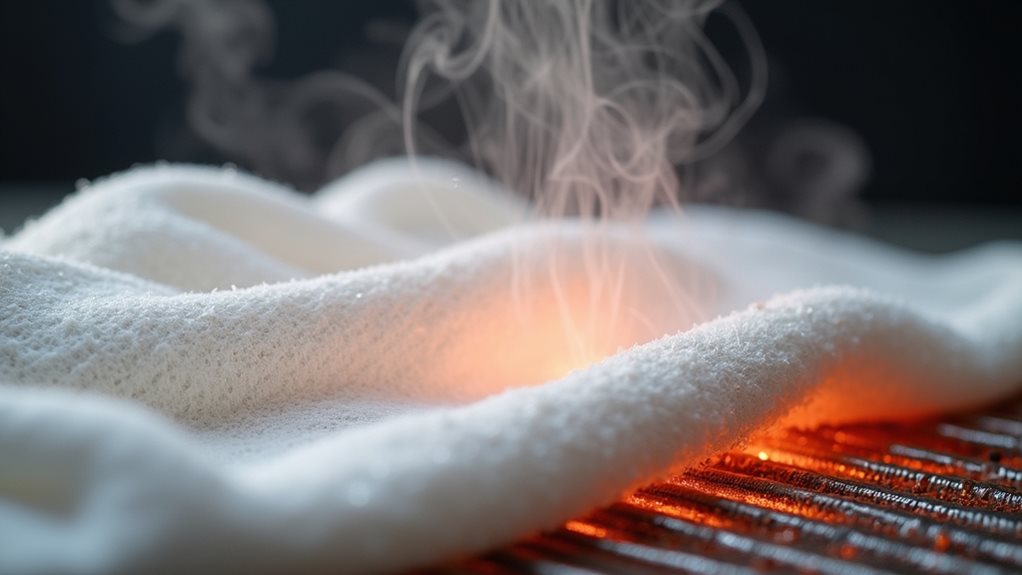
When you toss that dryer-activated cloth into your machine with your wrinkled blazer, you’re actually witnessing a fascinating dance of chemistry and physics that would make your high school science teacher proud 🧪.
The heat from your dryer transforms the water in that special cloth into powerful steam that works like tiny molecular messengers, carrying the emulsifier deep into your fabric’s fibers where it can break apart stain particles and odor molecules.
It’s honestly pretty amazing how thermal energy becomes your cleaning ally, penetrating places that surface treatments simply can’t reach, though I’ll admit I still get a little thrill watching that wrinkled mess transform into something presentable again.
While these home kits offer convenience, professional dry cleaning uses chemical solvents like perchloroethylene to achieve deeper cleaning results that water-based methods simply cannot match.
Heat Generates Steam Power
The magic behind home dry cleaning kits lies in something you’ve probably taken for granted every time you’ve tossed wet clothes into your dryer – the transformative power of heat.
When your dryer reaches ideal temperature, it triggers a fascinating chain reaction that turns those special cloths into miniature steam engines. The heat causes water molecules within the cloth to rapidly evaporate, creating pressurized steam that penetrates deep into your garments’ fibers.
This steam acts like tiny janitors, loosening dirt particles and neutralizing odors while being gentle enough for delicate fabrics. Unlike harsh chemical solvents that can damage sensitive materials, this steam-powered cleaning method refreshes your clothes using nature’s most basic elements: water and thermal energy.
The controlled heat and tumbling action work together with cleaning vapors released from the activated cloths to lift oils and embedded dirt from fabric fibers.
It’s surprisingly effective!
Thermal Energy Penetrates Fibers
As thermal energy builds inside your dryer, something remarkable happens at the molecular level that transforms ordinary heat into a powerful cleaning force.
When you’re using dry-cleaning kits, you’re fundamentally becoming a mini scientist, watching thermal energy work its magic on your favorite garments. The heat doesn’t just warm your clothes—it creates microscopic steam particles that wiggle their way deep into clothing fibers, like tiny janitors with determination.
- Steam molecules penetrate fabric weaves more effectively than liquid cleaners ever could
- Thermal energy loosens dirt particles without harsh chemical scrubbing
- Water-based stains respond beautifully to this gentle heat treatment
- Delicate fabrics maintain their integrity while getting refreshed
- The process mimics expensive professional methods right in your home 🏠
While these home cleaning methods work well for regular garments, remember that professional dry cleaning may still be necessary for specialized uniforms or work clothing that requires proper documentation for tax purposes.
Emulsifier Breaks Down Stains
Heat alone can’t tackle every stain challenge you’ll encounter, which is where the real chemistry genius of dry-cleaning kits reveals itself through specialized emulsifiers.
These clever compounds work like tiny molecular matchmakers, breaking down the surface tension between oil-based stains and water molecules.
When your cleaning cloths heat up in the dryer, the emulsifier activates and creates this amazing steam environment that penetrates deep into fabric fibers—think of it as giving your clothes a spa treatment! 😊
The magic happens when steam and emulsifier team up to gently lift away grease and grime without harsh chemicals, making this method perfect for delicate fabrics that would normally require expensive professional cleaning.
Unlike traditional washing methods that rely on water and mechanical agitation, this approach preserves the structure and color of sensitive materials.
It’s honestly fascinating how science mimics traditional dry-cleaning methods.
Components and Materials Inside Each Kit

Opening a home dry cleaning kit for the first time feels a bit like unwrapping a miniature chemistry set, complete with mysterious pouches and specialized tools that promise to transform your wrinkled, slightly funky blazer into something presentable again.
Each home dry cleaning kit contains carefully selected components that work together to clean delicate fabrics without water or harsh chemicals.
Inside you’ll find:
- Stain remover stick – targets water-based and light stains before the cleaning process
- Mylar foil bag – traps steam to release wrinkles and odors from delicate garments
- Dryer-activated cloths – contain water, perfume, and emulsifiers that create cleaning steam when heated
- Absorbent pads – help treat stubborn stains and protect fabrics during treatment
- Detailed instructions – guide you through proper usage for maximum effectiveness
These kits work best on garments with light stains and odors, using the heat from your dryer to activate the cleaning process.
Step-by-Step Process of Home Dry Cleaning
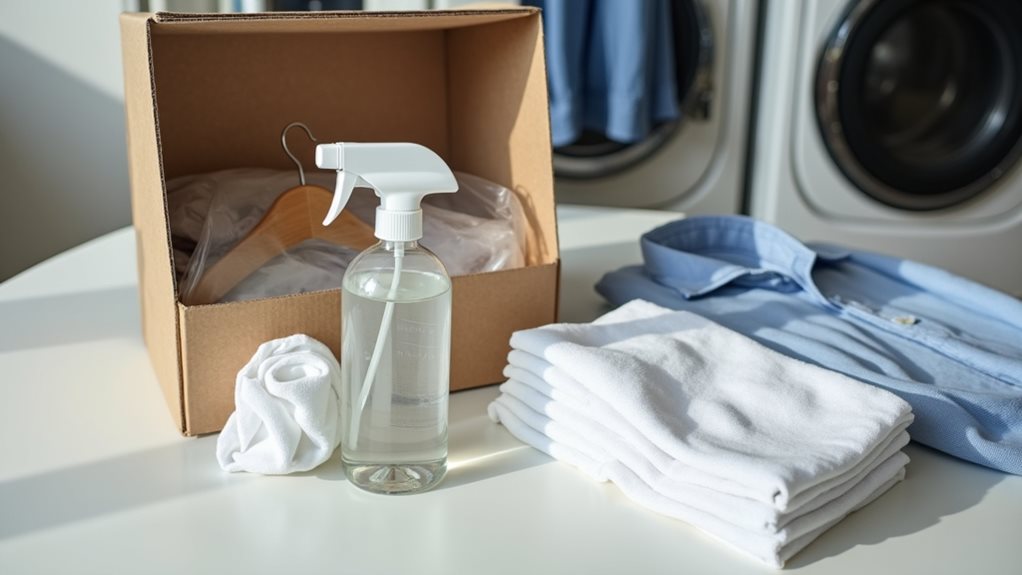
Three simple steps transform your at-home dry cleaning experience from intimidating chemistry experiment into something surprisingly manageable, though I’ll admit my first attempt left me wondering if I’d accidentally created a small sauna in my dryer.
Start with the pre-treatment stage, gently applying stain remover to any visible spots—don’t scrub aggressively like you’re washing dishes, just dab with patience.
Next, place your garments inside the Mylar bag alongside the dryer-activated cloths, which become your secret steam-generating weapons.
Set your dryer to medium-high heat for thirty minutes, and let the magic happen as steam penetrates every fiber.
Remember to remove everything promptly; otherwise, you’ll spend more time ironing than you saved with home dry cleaning.
Before starting any treatment, always test your chosen method on an inconspicuous area first to ensure the fabric care labels recommendations won’t cause unexpected damage to your garment.
Effectiveness on Different Types of Stains and Fabrics
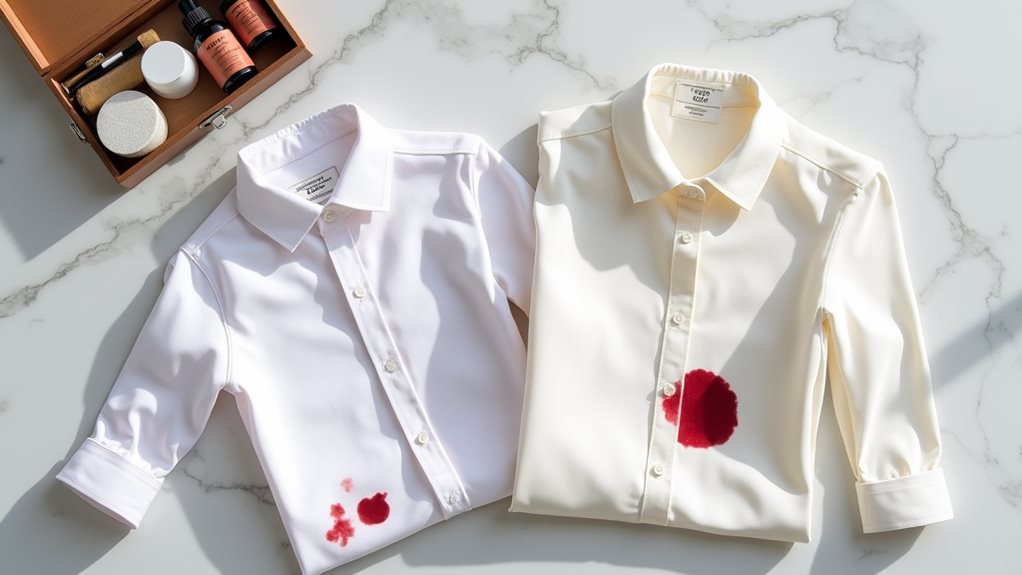
When you’re deciding whether to use that home dry cleaning kit sitting in your laundry room, you’ll want to take into account what type of stain you’re dealing with and what fabric you’re treating.
I learned this the hard way when I confidently tossed my silk blouse with a mysterious coffee stain into one of those kits, only to discover that while water-based stains like sweat or light spills respond beautifully to the gentle steaming process, stubborn oil-based stains from salad dressing or makeup require the heavy-duty solvents that only professional cleaners can provide.
Your fabric choice matters just as much as the stain type, since delicate materials like silk and wool thrive under the kit’s gentle treatment, but I’ve seen too many people accidentally ruin leather jackets and suede boots by assuming all “fancy” fabrics work the same way 😅.
Before using any kit, always test the method on an inconspicuous area first to ensure your garment won’t suffer damage from the cleaning process.
Water-Based Stain Removal
Although home dry cleaning kits might seem like magic in a box, they’re actually quite selective about which stains they’ll tackle effectively, and understanding their limitations can save you from the heartbreak I experienced when I tried to revive my favorite coffee-stained blazer.
Water-based stain removal represents the sweet spot where home dry cleaning truly shines, as the stain remover solution dissolves these pesky marks with surprising efficiency.
Here’s what you need to know about tackling water-based stains:
- Always pre-treat visible stains before tossing garments into the kit
- Cotton and polyester respond beautifully to the cleaning process
- Delicate fabrics like silk require extra gentle handling during treatment
- Fresh stains disappear more easily than their stubborn, set-in cousins
- Steam helps refresh fabrics but won’t penetrate deeply embedded stains
While home kits excel at water-based stains, they struggle with oil-based stains like grease and makeup that professional dry cleaning handles more effectively.
Oil Stain Limitations
While water-based stains might surrender easily to your home dry cleaning kit, oil-based stains present an entirely different battlefield where these convenient solutions often wave the white flag in defeat.
Here’s the harsh reality: those steaming processes you’re relying on simply can’t penetrate deep enough to lift greasy residues from fabric fibers. Your kit excels at revitalizing and deodorizing, but oil stains demand specialized cleaning agents that pack more punch than what’s tucked inside that convenient box.
Delicate fabrics like silk and wool become particularly stubborn opponents, clinging to oil molecules like they’re precious treasures.
Professional dry cleaners use chemical solvents like perchloroethylene that dissolve oils and grease more effectively than water-based treatments, making them far superior for tackling these challenging stains.
When you’re facing notable grease battles, it’s time to surrender gracefully and seek professional dry cleaning services equipped with solvents designed for deep cleaning warfare.
Fabric Type Compatibility
Three distinct fabric categories will determine whether your home dry cleaning kit becomes your laundry hero or leaves you feeling defeated, and understanding these differences can save you from costly mistakes that I’ve watched countless people make over the years.
Your fabric type fundamentally dictates success rates, and I’ve learned this through some embarrassing mishaps myself. Most “dry clean only” items like silk and wool can be cleaned at home with decent results, though I’ve seen mixed outcomes depending on types of stains involved.
Here’s what works best with home kits:
- Delicate garments with light, water-based stains respond beautifully
- Lace and embroidery benefit from gentle steaming action
- Silk blouses handle freshening treatments surprisingly well
- Wool sweaters maintain their shape when processed carefully
- Cotton-synthetic blends show consistent, reliable results
However, leather, fur, and velvet absolutely require professional cleaning—trust me on this one! 😅
Benefits and Limitations of At-Home Cleaning
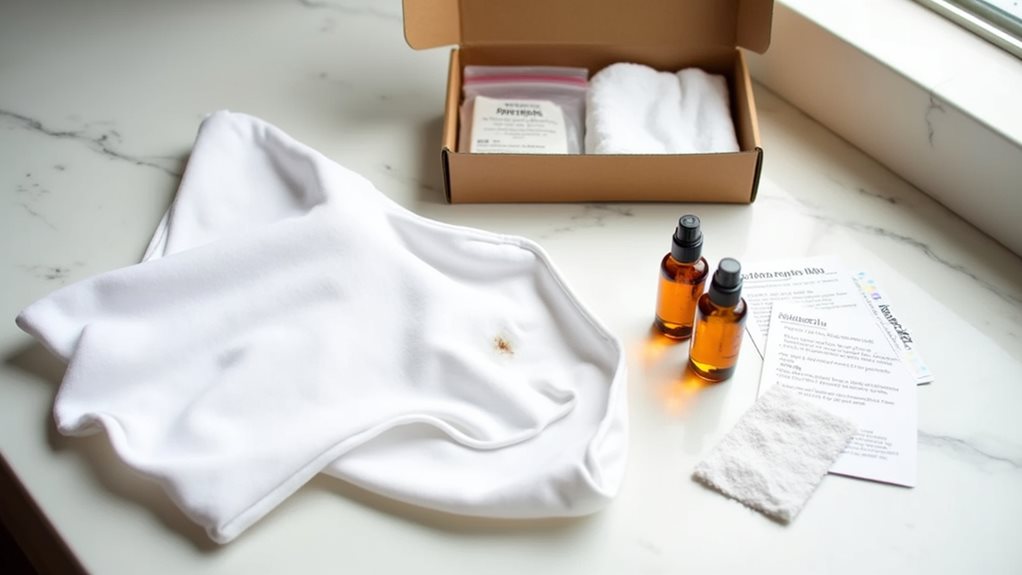
Since you’re probably weighing whether to invest in an at-home dry cleaning kit, I’ll share what I’ve learned after testing several brands over the past few years, complete with a few embarrassing mishaps that taught me valuable lessons.
These cleaning kits excel at rejuvenating garments between professional cleaning sessions, and honestly, they’re budget-friendly lifesavers for maintaining your wardrobe.
However, their limitations become glaringly obvious when facing stubborn stains or spots—trust me, that red wine incident taught me the hard way 😅.
While at-home dry cleaning works beautifully for light maintenance and deodorizing, don’t expect miracles with set-in stains or delicate fabrics. You’ll still need professional cleaning for serious mishaps and specialty materials.
Suitable Garments for Home Dry Cleaning Kits

Understanding which garments work best with home dry cleaning kits can save you from the kind of expensive mistakes I made when I first started experimenting with these products.
I learned the hard way that suitable garments typically include delicate garments made from synthetic fibers and cotton blends, which respond beautifully to steam cleaning without risking damage.
Here’s what works well with home dry cleaning kits:
- Light wool sweaters and blouses that need gentle revitalization
- Bedding items like sheets, pillowcases, and comforters
- Clothes with embellishments such as embroidery or delicate lace trim
- “Dry clean only” items (proceed cautiously though!)
- Synthetic fiber garments that just need odor removal
Avoid leather, suede, or heavily structured pieces—trust me on this one! 😅
Professional Dry Cleaning Vs Home Kit Comparison
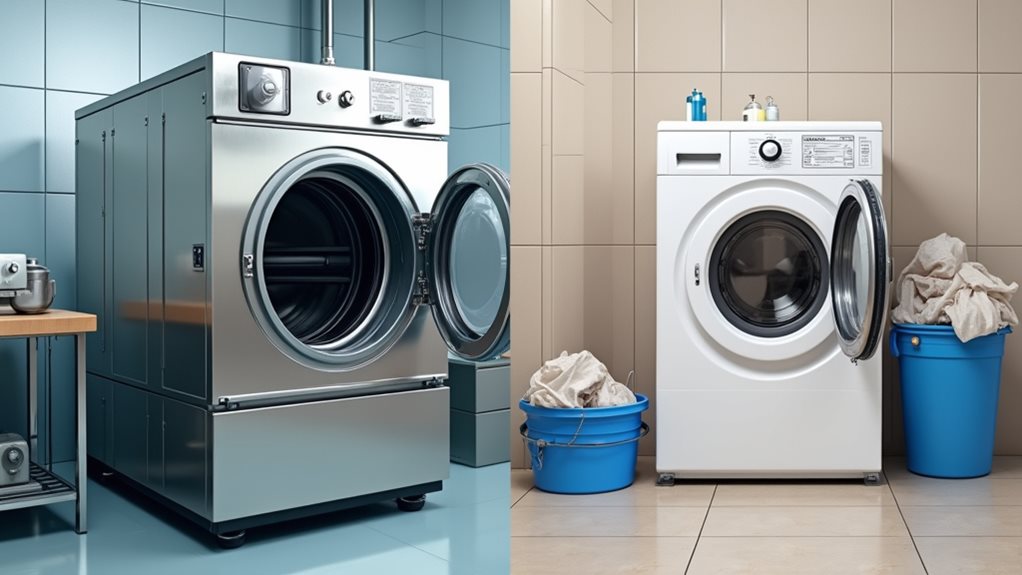
When I first discovered home dry cleaning kits, I thought I’d found the holy grail of garment care—until I compared my results with what my neighborhood dry cleaner could accomplish, and the differences were honestly pretty eye-opening.
Professional dry cleaning uses powerful solvents like perchloroethylene that penetrate fabrics completely, while home dry cleaning kits rely on steam and gentle cleaners for surface-level rejuvenation.
You’ll notice the biggest gap when tackling deep stains—those coffee spills or sweat marks that home kits simply can’t handle effectively.
Professional services also excel with delicate materials like silk and wool that need specialized care.
Sure, home kits are more cost-effective for quick touch-ups, but they’re fundamentally different tools for different jobs in your garment care arsenal.

